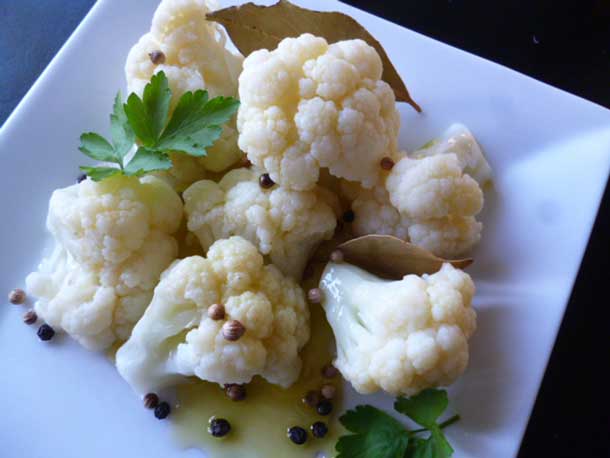

THUNDER BAY – FOOD NOW – (Zester Daily) – Although cauliflowers are sold in our supermarkets all year round, this beautiful member of the wild cabbage family (Brassica oleracea) is at its bright and healthy best in early spring. Cauliflowers harvested at that time have had the benefit of a longer growing season (about 80 days, instead of 50 days for their summer-grown counterparts), allowing their valuable nutrients more time to develop.
The cauliflower, whose name derives from the Latin caulis (stem) and floris (flower) is actually a cabbage bred for its flowers. The edible part of the plant, the head of tender stems and flower buds, is known as a curd. Similarly to broccoli and calabrese (close relatives), the cauliflower stores nutrients for the developing flowers at the base of the buds, so a fresh, crisp curd is packed full of vitamins and minerals. Its Latin botanical name, Brassica oleracea var. botrytis (meaning cluster, or grapelike), is an apt description of this remarkably clever vegetable, which grows with a protective layer of leaves curled around its head.
Hats off to the French, though, for giving cauliflower (chou-fleur, or cabbage-flower,) a prettier, and horticulturally more correct name, than the rather pedestrian Anglo-Saxon “flower on a stalk.”
Mysterious origins
There is disagreement over the origin of the cauliflower. Some say it was developed by 11th century Arab gardeners, or by Romans a thousand years earlier. But the wild cabbage grew throughout the ancient eastern Mediterranean and, with its tendency to produce “freaks,” prototypes of the cauliflower probably originated spontaneously in different places. Curious gardeners have since, through seed selection, improved nature’s work and we are now reaping the benefits.
Medieval Italian kitchens and, later, those of Louis XIV of France, served stylish and elegant cauliflower dishes. Catherine de Medici is said to have appreciated the lovely vegetable, and to have introduced it to France to help alleviate arthritis. But its earlier French name, chou de Chypre, suggests it arrived from Cyprus and Cypriots are, understandably, happy to claim its origin. For the past 200 years, the cauliflower has been a popular winter vegetable in northern Europe, but without its former prestige in serious kitchens. Until now.
Hardly humble
With cauliflowers piled high in our markets, this inexpensive and highly nutritious brassica is at last losing its humble status and taking its rightful place on our tables. A reputation for being bland and soggy is the fault of the cook, not of the cauliflower. Its very gentleness is the perfect foil to many fine flavors, and it takes only a few minutes to cook.
“Organic” and “local” have real meaning when selecting cauliflowers: snails, aphids and caterpillars love them, so pesticides are often used and, once harvested, their nutrients and flavor dissipate quickly. Most cauliflowers are attractively creamy-white, but we also have wonderfully colorful varieties. Buy cauliflowers that smell and look fresh, with deep-green, outer leaves and tight heads; avoid brown-spotted white ones, or dull-looking purple, yellow or green heads. Size doesn’t affect flavor, but age does: older cauliflowers taste and smell stronger.
Richer in vitamins and minerals than any other brassica, cauliflowers are an excellent source of vitamin C, folic acid and potassium; a very good source of niacin, copper, manganese and vitamins A, K, B5 and B6; and a good source for protein, phosphorous, magnesium and vitamins B2 and B3. Raw, they are even better.
Avoid nutricide
Cauliflower cooks quickly: Keep florets whole or cut large ones in half and simmer in a little water or steam for five minutes. After this time, cauliflower loses 20% to 30% of its phytochemicals; after 10 minutes, 40% disappear. Where possible, cook in ways that don’t commit nutricide – in soups and stews, grilled or baked. In its wonderful ability to host spicy flavors, some of the best preparations for cauliflower can be found in the kitchens of the Indian subcontinent and the Mediterranean. With winter soon drawing to an end, it’s time to enjoy the vegetable that has spent the past three months developing the nutrients we need to take us into a healthy spring.
Simple Greek ways to serve
Serve raw or lightly-steamed small florets with a dip of mashed anchovy, capers, herbs, and olive oil or with hummus, small radishes and young wild green leaves.
Mix thinly sliced cauliflower florets and fine-julienned carrots with olive oil, lemon juice, sea salt, lightly chopped flat-leaf parsley, and Greek oregano (rigani ).
Dip small florets in a light garbanzo-flour batter and gently fry the fritters in olive oil; serve with olive oil and lemon juice mayonnaise, olives, and lemon wedges.
Cauliflower à la Greque
À la Greque (French for “in the Greek style”) describes a method of cooking, one that presumably a French cook/traveler admired and added to his/her own kitchen repertoire. There are many versions of this popular dish, but most are a pale imitation of the original Greek creation. Buy the freshest cauliflower you can find and, for a lightly spiced dish, prepare two hours ahead; for a more mellow taste and texture, leave overnight in the marinade.
Prep time: 5 minutes
Cook time: 12 minutes
Total time: 17 minutes
Yield: 8 for a meze serving, 4 as a vegetable dish
Ingredients
4 cups small cauliflower florets
4 tablespoons extra virgin olive oil
2 tablespoons dried coriander seeds
1 cup dry white wine
3 bay leaves
1/2 tablespoon aromatic honey such as Hymettus
1 tablespoon cracked black peppercorns
Coarse-grain sea salt to taste
For serving:
4 tablespoons flat-leaf parsley, coarsely chopped
1 tablespoon lemon zest, in very thin strips, optional
Lemon wedges
Directions
1. Trim most of the stem from the florets and cut an “x” in the base of each with a small sharp knife. Blanch 1 minute in boiling water, drain, and set aside.
2. Heat the olive oil in a large heavy saucepan over low heat. Add the coriander seeds and florets in a single layer and stir with a wooden spoon to coat with the olive oil. Add the wine, bay leaves, honey, pepper and salt. Bring just to a boil, cover, reduce the heat, and simmer 10 minutes or until tender.
3. Transfer the contents of the pan to a nonreactive bowl and set aside until cool. Cover the bowl and shake it gently to redistribute the marinade.
4. To serve, taste the marinade. If more salt is needed, combine with the parsley. Transfer the cauliflower to a shallow serving bowl and pour over most of the marinade (strain it first, if you prefer). Sprinkle with parsley and lemon zest and serve with the lemon wedges.
Copyright Rosemary Barron via Zester Daily and Reuters Media Expres






